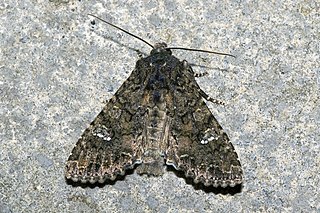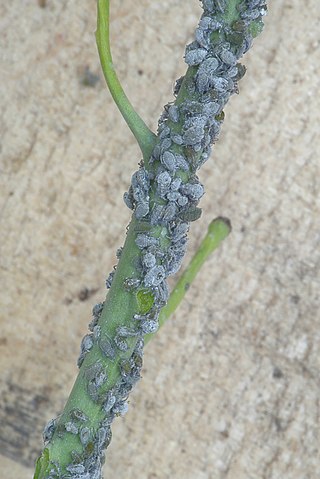
Brassicaceae or Cruciferae is a medium-sized and economically important family of flowering plants commonly known as the mustards, the crucifers, or the cabbage family. Most are herbaceous plants, while some are shrubs. The leaves are simple, lack stipules, and appear alternately on stems or in rosettes. The inflorescences are terminal and lack bracts. The flowers have four free sepals, four free alternating petals, two shorter free stamens and four longer free stamens. The fruit has seeds in rows, divided by a thin wall.

Cabbage, comprising several cultivars of Brassica oleracea, is a leafy green, red (purple), or white biennial plant grown as an annual vegetable crop for its dense-leaved heads. It is descended from the wild cabbage, and belongs to the "cole crops" or brassicas, meaning it is closely related to broccoli and cauliflower ; Brussels sprouts ; and Savoy cabbage.

Broccoli is an edible green plant in the cabbage family whose large flowering head, stalk and small associated leaves are eaten as a vegetable. Broccoli is classified in the Italica cultivar group of the species Brassica oleracea. Broccoli has large flower heads, or florets, usually dark green, arranged in a tree-like structure branching out from a thick stalk, which is usually light green. The mass of flower heads is surrounded by leaves. Broccoli resembles cauliflower, which is a different but closely related cultivar group of the same Brassica species.

Pieris rapae is a small- to medium-sized butterfly species of the whites-and-yellows family Pieridae. It is known in Europe as the small white, in North America as the cabbage white or cabbage butterfly, on several continents as the small cabbage white, and in New Zealand as the white butterfly. The butterfly is recognizable by its white color with small black dots on its wings, and it can be distinguished from P. brassicae by its larger size and the black band at the tip of its forewings.

The heart and dart is a moth of the family Noctuidae. The species was first described by Carl Linnaeus in his 1758 10th edition of Systema Naturae. A familiar moth to many, it is considered one of the most common of the European region. It occurs throughout the Palearctic realm from Ireland to Japan.

The large yellow underwing is a moth, the type species for the family Noctuidae. It is an abundant species throughout the Palearctic realm, one of the most common and most familiar moths of the region. In some years the species is highly migratory with large numbers appearing suddenly in marginal parts of the range.
The term cabbage worm is primarily used for any of four kinds of lepidopteran larvae that feed on cabbages and other cole crops. Favorite foods include broccoli, cauliflower, Brussels sprouts, collards, kale, mustard greens, turnip greens, radishes, turnips, rutabagas and kohlrabi. This small group of similar pest species is known to agriculturists as the cabbage worm compte butterflies.

The cabbage moth is primarily known as a pest that is responsible for severe crop damage of a wide variety of plant species. The common name, cabbage moth, is a misnomer as the species feeds on many fruits, vegetables, and crops in the genus Brassica. Other notable host plants include tobacco, sunflower, and tomato, making this pest species particularly economically damaging.

The diamondback moth, sometimes called the cabbage moth, is a moth species of the family Plutellidae and genus Plutella. The small, grayish-brown moth sometimes has a cream-colored band that forms a diamond along its back. The species may have originated in Europe, South Africa, or the Mediterranean region, but it has now spread worldwide.

The silver Y is a migratory moth of the family Noctuidae which is named for the silvery Y-shaped mark on each of its forewings.

Brevicoryne brassicae, commonly known as the cabbage aphid or cabbage aphis, is a destructive aphid native to Europe that is now found in many other areas of the world. The aphids feed on many varieties of produce, including cabbage, broccoli (especially), Brussels sprouts, cauliflower and many other members of the genus Brassica, but do not feed on plants outside of the family Brassicaceae. The insects entirely avoid plants other than those of Brassicaceae; even though thousands may be eating broccoli near strawberries, the strawberries will be left untouched.

Napa cabbage is a type of Chinese cabbage originating near the Beijing region of China that is widely used in East Asian cuisine. Since the 20th century, it has also become a widespread crop in Europe, the Americas, and Australia. In much of the world, it is referred to as "Chinese cabbage".

Hellula hydralis, the cabbage centre grub, is a moth of the family Crambidae. It was described by Achille Guenée in 1854 and is found throughout Australia.

Hellula is a genus of moths of the family Crambidae. It was described by Achille Guenée in 1854

Crocidolomia pavonana is a moth of the family Crambidae. Its caterpillar is a crop pest and is known as the croci or the cabbage cluster caterpillar. This moth is found in Africa and Asia, its range extending from South Africa through India to the Pacific Ocean, including Australia. The wingspan is about 25 mm (1 in). The larvae feed on Brassicaceae species and are considered an agricultural pest on cabbages. The species was first described by Johan Christian Fabricius in 1794.

Herpetogramma licarsisalis, commonly known as the grass webworm or pale sod-webworm, is a species of moth in the family Crambidae.

Hellula rogatalis, the cabbage webworm, is a moth of the family Crambidae described by George Duryea Hulst in 1886. It is found from the southern United States north in the east to Maryland, New York and Ontario. It is also found in Mexico, where it has been recorded from Distrito Federal.

Lipaphis erysimi is a species of aphid of the family Aphididae. Its common names include mustard aphid and turnip aphid. It is found in most temperate and tropical areas of the world and feeds only on cruciferous plants. The insects are almost exclusively female and are very prolific, with wingless females producing around one hundred young during a lifespan of a few weeks.

















